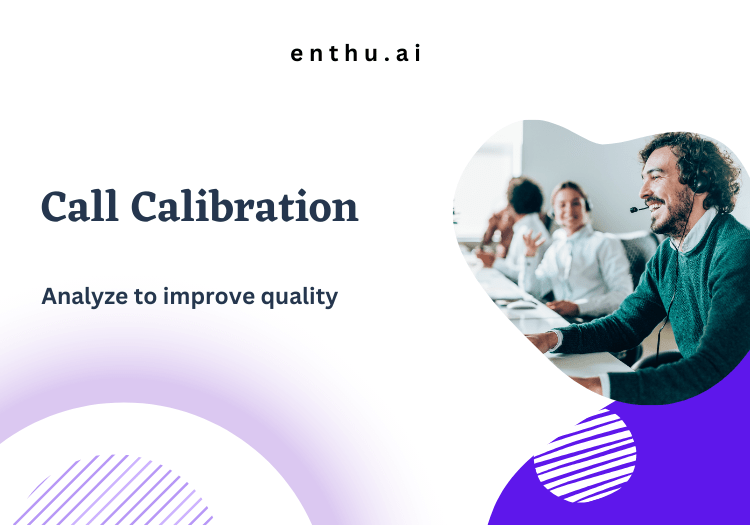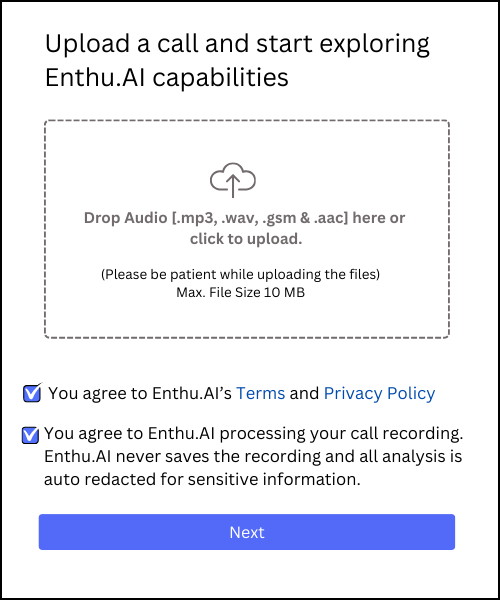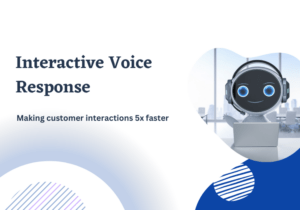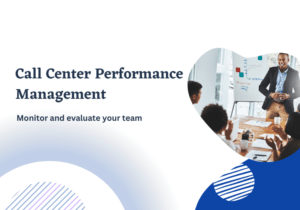Explore everything about call center call collaboration: What call calibration is, its importance, and best practices to improve it.
Picture this: One of your customers reaches out to your call center to resolve an issue.
His experience on that call can shape his perception of your entire company.
Now, consider this scenario playing out thousands of times a day across call centers worldwide.
How do companies ensure that every customer interaction is not just good but consistently excellent?
Quality management teams play a vital role in this process, and one unique tool they use is called calibration.
In customer service, each call is an opportunity to make a positive impression. Good communication is about providing answers and ensuring every interaction leaves customers happy and confident in your service.
Recent research revealed that 80% of customers now think a company’s customer experience is just as crucial as its products and services.
This places an immense responsibility on call centers to handle calls and excel in every conversation.
This is where the concept of call calibration ensures that each agent’s performance contributes to an overall symphony of quality assurance.
In this guide, you’ll find:
- What is call calibration ?
- Importance of call center call calibration.
- What are calibration sessions?
- Step to Do Call Calibration for Quality Assurance
- Find the Best Call Analytics Software for Your Business?
- Best Practices for Effective Call Calibration
A. What is call calibration?
Call calibration is like a team meeting in a call center where everyone reviews customer service calls together.
The goal is to make sure everyone agrees on what makes a good interaction with customers.
This way, even as the team grows, everyone stays on the same page about what’s expected.
During these meetings, managers, supervisors, and call center agents listen to the same recorded call and rate it based on a set of standards.
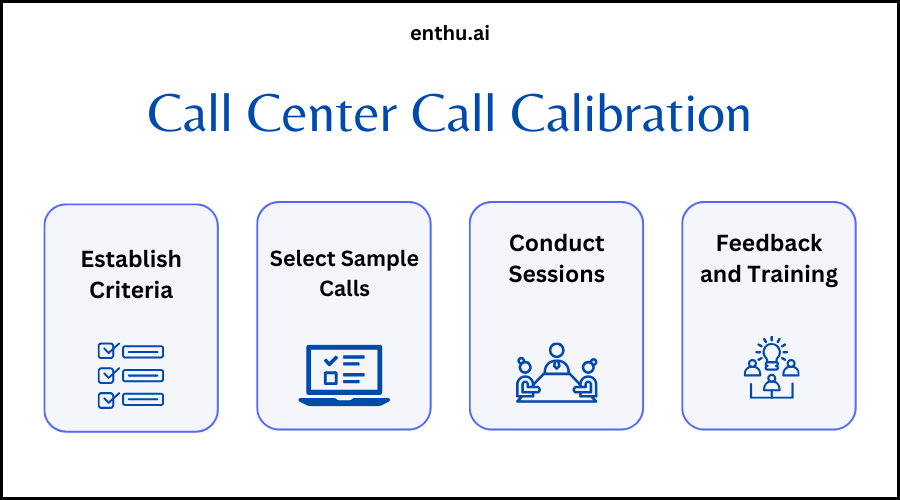
The idea is to catch any differences in how people score calls and talk about why that might happen.
This process is super important because it helps managers, supervisors, and QA evaluators consistently check how well agents are performing in customer interactions.
It also allows everyone to agree on what’s considered good quality service.
And if needed, the meeting might suggest changes to improve how they evaluate calls.
Doing this regularly, ideally every month or when things change, helps maintain high-quality customer service in the call center.
B. Why is call calibration important in call centers?
Here are the key reasons why call calibration matters in call centers:
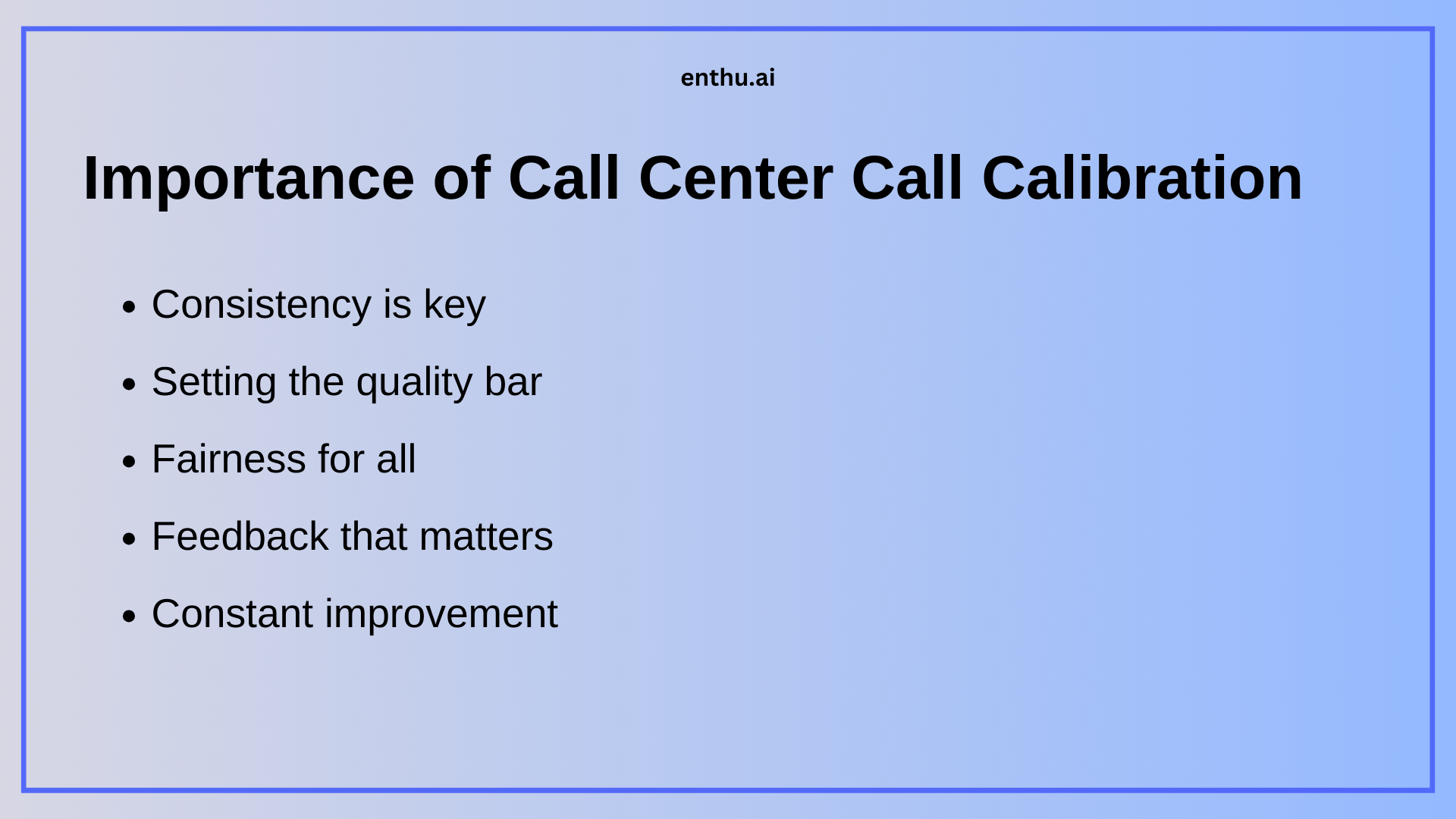
1. Consistency is key
Call calibration helps everyone in the team use the same standards when evaluating calls.
This consistency is crucial to avoid biases and make sure that everyone is on the same page about what’s considered good customer service.
2. Setting the quality bar
By defining quality standards, call calibration ensures that agents, team leads, and supervisors know what’s expected during customer interactions.
This clarity helps maintain a high level of service throughout the organization.
3. Fairness for all
Call calibration minimizes the chances of favoritism or bias in evaluations.
It creates a level playing field for all agents, as feedback is consistent across the board, promoting fairness and objectivity.
4. Feedback that matters
During calibration sessions, evaluators get a chance to provide specific and actionable feedback to agents.
This helps agents understand where they excel and where there’s room for improvement, contributing to ongoing professional development.
5. Constant improvement
Call calibration is not just about evaluating calls; it’s a tool for refining training programs.
The insights gained from these sessions allow managers to identify gaps in agent training, ensuring that agents continually improve and deliver top-notch customer service.
C. What are call calibration sessions?
Calibration sessions are collaborative meetings where call center agents, supervisors, managers and quality assurance team come together to review and discuss specific customer interactions.
In these sessions, they talk about and review the ratings (scores) they gave to the same call, making sure everyone agrees on what’s good or not.
During these meetings, they try to figure out if the calls were scored accurately and discuss what could be done differently.
They also decide how similar calls should be rated in the future.
They check if the rules and standards they use are still good or if they need to be changed.
The goal is to keep the ratings consistent among everyone in the team, making sure there’s not too much difference in how they score calls.
It’s kind of like a fairness check to make sure everyone is on the same page when it comes to evaluating calls.
This helps keep things fair, so a tough grader and an easy grader in the team balance out, ensuring everyone gets an honest and accurate performance review.
D. Steps to perform call calibration for quality assurance
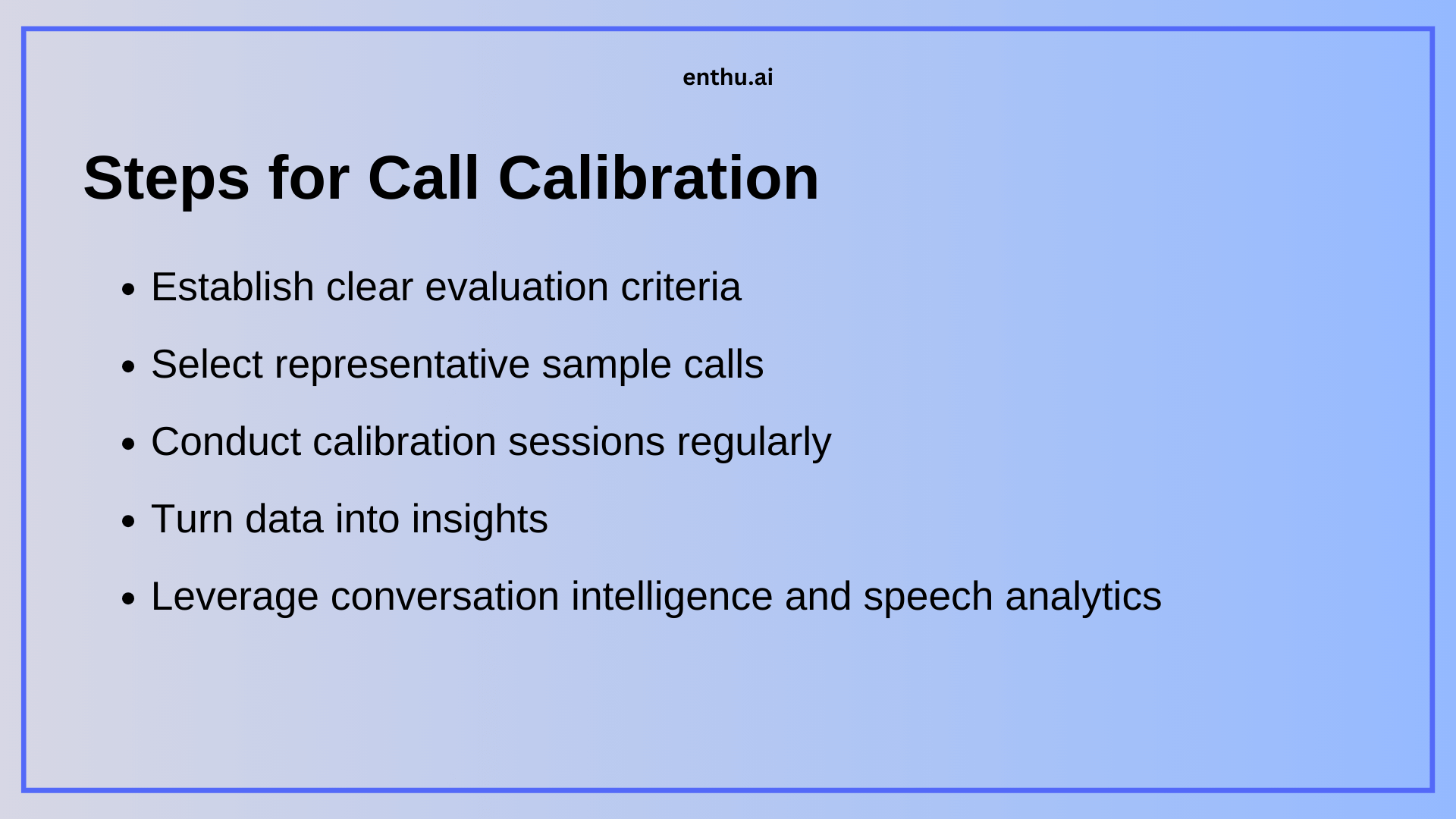
1. Establish clear evaluation criteria
Before diving into calibration sessions, it is essential to establish clear and comprehensive evaluation criteria.
These criteria should cover various aspects of customer interactions, including communication skills, adherence to scripts, problem-solving abilities, and overall customer satisfaction.
Having well-defined criteria ensures that evaluations are consistent and focused on key performance indicators.
2. Select representative sample calls
Choose a diverse set of customer calls to include in the calibration process.
The selected calls should represent various scenarios and challenges that agents commonly encounter.
This diversity allows for a more comprehensive assessment of agent performance and ensures that calibration sessions address a wide range of situations.
3. Conduct calibration sessions regularly
Consistency is critical in call calibration.
Regular calibration sessions, whether weekly or monthly, create a continuous feedback loop that promotes improvement over time.
During these sessions, participants can discuss specific interactions, share insights, and collectively refine the evaluation process.
The frequency of sessions depends on the call center’s size and operational requirements.
3. Turn data into insights
After you and your team discuss and compare calls in the calibration sessions, it’s important to use the information wisely.
Don’t just keep it stored away; think about how it can help you improve.
The data from these sessions is like a treasure trove.
It lets you take a closer look at your process and give feedback to the people doing the evaluations.
It’s also a handy tool for improving your call quality scorecard.
The key is to use what you’ve learned to make positive changes in your call center.
Invest in a good platform for analysing your QA scorecard such as Enthu.AI

4. Leverage conversation intelligence and speech analytics
Embrace technology to enhance the calibration process. Conversation intelligence can provide valuable insights into customer interactions.
These tools analyze calls for sentiment, key phrases, and customer emotions, offering a data-driven approach to calibration.
Integrating such technologies ensures a more objective and insightful evaluation of agent performance.
E. Find the best call analytics software for your business
Investing in the right speech analytics software is crucial for an effective call calibration process. There are several call analytics solution available, each offering unique features and capabilities.
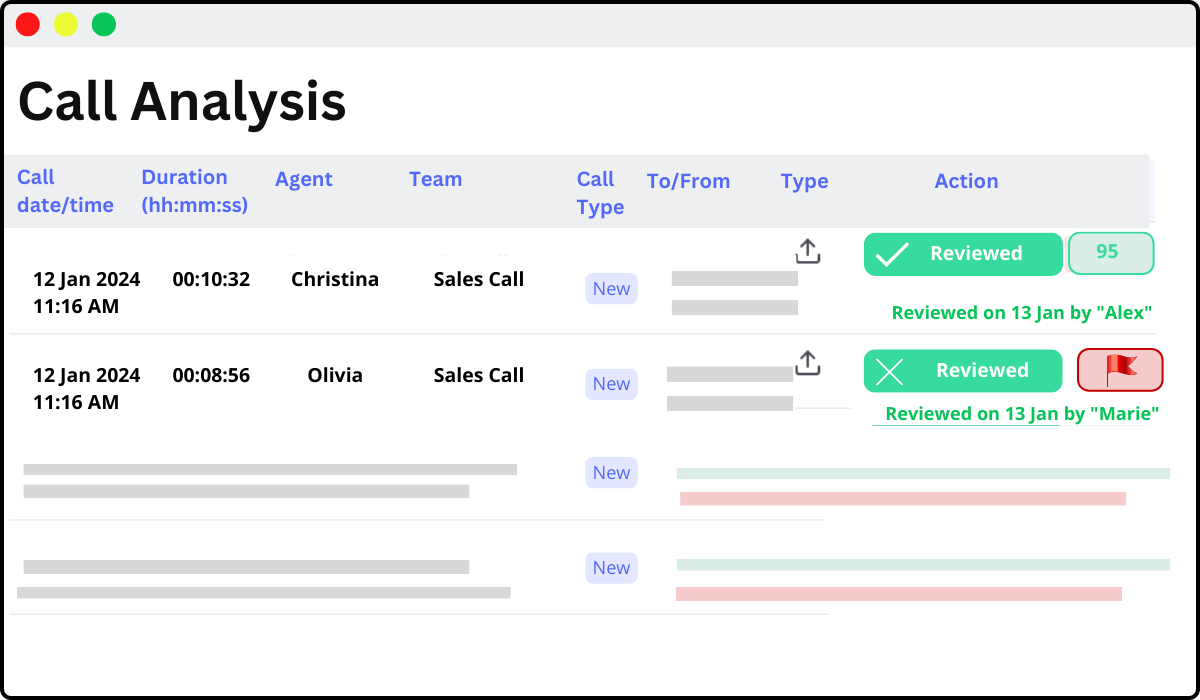
Consider factors such as scalability, ease of use, and compatibility with your call center’s existing systems.
Enthu.AI is one such platform that provides comprehensive call analytics and calibration solutions.
Enthu.AI includes call monitoring, transcripts, customizable QA evaluation forms, and in-depth analytics.
The platform facilitates collaboration among team members and streamlines the calibration process, making it a valuable asset for call centers aiming to enhance their quality assurance efforts.
F. Best practices for effective call calibration

1. Establish session goals:
Before every call calibration session, clearly define specific objectives.
For instance, you might aim to adjust quality criteria or ensure that evaluators are aligned with established standards.
These goals provide a focused discussion agenda, making the calibration process more targeted and productive.
2. Foster open communication
Create an environment where open communication is encouraged during calibration sessions.
This involves promoting a culture where all participants, including agents and supervisors, feel comfortable sharing their viewpoints.
This collaborative approach ensures that diverse perspectives are taken into account, leading to a more comprehensive and fair evaluation process.
3. Focus on constructive feedback
Shift the focus of calibration sessions from criticism to improvement.
Provide constructive feedback, emphasizing the strengths of agents and areas where improvement is possible.
This positive approach motivates agents to enhance their skills, fostering a supportive and growth-oriented atmosphere within the call center.
4. Set a calibration baseline
Determine a specific percentage, commonly around 5%, that represents the acceptable difference in scores among evaluators.
If the scores fall below this baseline, it indicates a successful calibration.
If discrepancies exceed the baseline, the calibration process continues until the desired level of consistency is achieved.
5. Document calibration outcomes
Maintain comprehensive records of each calibration session, including details of discussions, provided feedback, and action plans.
These records serve as a valuable reference for future evaluations and allow for tracking agents’ progress over time.
Documentation enhances accountability and ensures that agreed-upon improvements are implemented consistently.
6. Leverage AI and automation
Harness the power of AI-driven speech analytics tools to automate the monitoring process.
These tools transcribe calls, analyze them based on predefined criteria, identify keywords, deviations, and even assess emotional tones through sentiment analysis.
Automation enhances the efficiency and accuracy of the calibration process, providing data-driven insights.
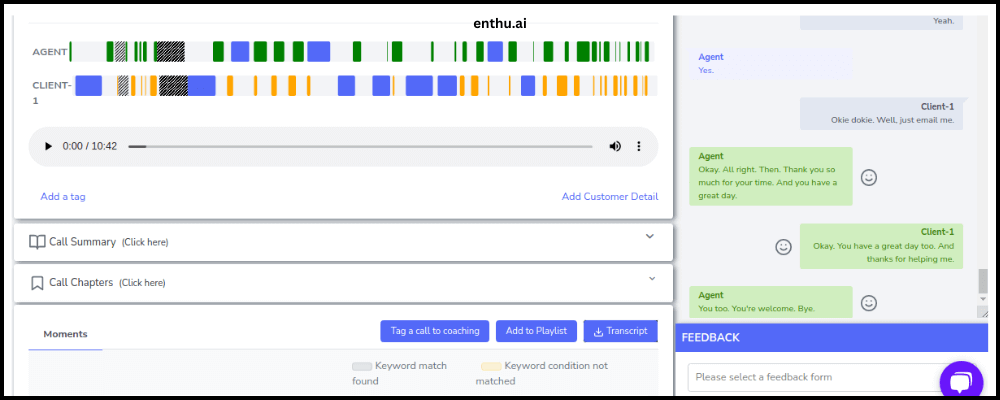
7. Embrace continuous training
Integrate call calibration seamlessly into ongoing training programs.
Use insights gathered from calibration sessions to identify specific training needs and tailor development programs accordingly.
This integration ensures that calibration becomes integral to continuous improvement, contributing to the overall growth and enhancement of call center operations.
Conclusion
Call calibration is like the backbone of excellent customer service in a call center.
It’s important to ensure everything runs smoothly and customers get the best help.
By following the call calibration steps and best practices mentioned in this post, and leveraging modern technologies like conversation intelligence, call monitoring, and speech analytics, call centers can create a robust system for call calibration.
This system helps keep the service quality high and makes sure agents do their best.
Remember, it’s not something you do just once; it’s a continuous process that needs effort and teamwork.
When call centers really care about making sure things are top-notch, especially with quality assurance through good calibration, they pave the way for customer satisfaction and loyalty, ultimately driving the success of their operations.
FAQs
How often should call calibration sessions be conducted?
The frequency of call calibration sessions depends on the size and operational requirements of the call center. However, regular sessions, whether weekly or monthly, are recommended to ensure consistency and continuous improvement.
What role does technology play in call calibration?
Technology, such as conversation intelligence and speech analytics tools, enhances the call calibration process by providing data-driven insights into customer interactions. These tools contribute to more objective evaluations and facilitate a more efficient calibration workflow.
Can call calibration be integrated into agent training programs?
Yes, call calibration should be an integral part of agent training programs. Insights gained from calibration sessions can be used to identify training needs and tailor ongoing development programs, creating a seamless connection between calibration and continuous training initiatives.
